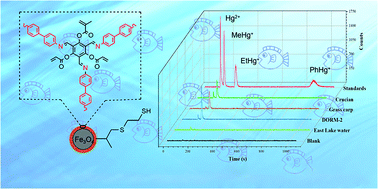Preparation of functional magnetic porous organic polymer as sorbent for mercury speciation followed by HPLC-ICP-MS analysis†
Abstract
A novel sulfur-containing functional core–shell magnetic porous organic polymer (Fe3O4@BD-TpMA-S-SH MOP) was synthesized as a magnetic solid-phase extraction (MSPE) sorbent for mercury speciation followed by high-performance liquid chromatography (HPLC)-inductively coupled plasma mass spectrometry (ICP-MS) detection. The prepared Fe3O4@BD-TpMA-S-SH MOP possessed rich active adsorption sites (S: 25 wt%), high magnetism (39.2 emu g−1) and high adsorption capacity (636, 656, 649 and 366 mg g−1 for Hg2+, methylmercury (MeHg+), ethylmercury (EtHg+) and phenylmercury (PhHg+), respectively). Under the optimal conditions, the limit of detection (LOD) of the developed MSPE-HPLC-ICP-MS method was 0.43, 0.55, 0.69 and 1.1 ng L−1 for Hg2+, MeHg+, EtHg+ and PhHg+, respectively, with a high enrichment factor (EF) in the range of 346–383-fold. The accuracy of the method was validated, and it was successfully applied for trace/ultratrace mercury speciation in environmental water and fish samples. The developed method has high sensitivity, low LOD, high EF, fast adsorption/desorption dynamics and good matrix resistance ability, showing great applicability in real sample analysis with complex sample matrices.



 Please wait while we load your content...
Please wait while we load your content...